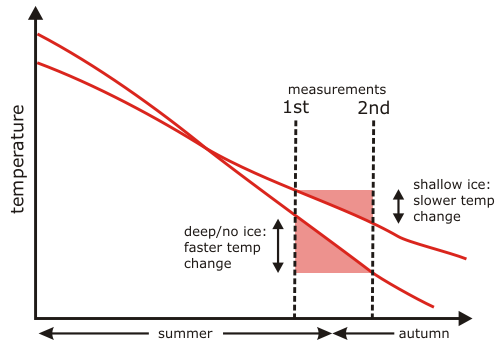Some interesting data from Mars Odyssey about the distribution of sub-surface ice on Mars were published in Nature last week by Joshua Bandfield at Arizona State University (see also here and here). Mars Odyssey had already detected the presence of extensive water ice at depths < 1-2m by using its Gamma Ray Spectrometer to measure the concentration of hydrogen. However, this instrument does not have a very high spatial resolution (of the order of hundreds of kilometres), so cannot resolve any local variations in the thickness or depth of the subsurface ice layer.
In contrast, the Thermal Emission Imaging System (THEMIS) has a much higher resolution – of the order of 100 metres. However, inferring the presence of subsurface ice with this instrument is a slightly more indirect process. Detection is based on the idea that martial soil, or regolith, will have a much higher thermal inertia when bound together with ice than it does as a loose aggregate; this means that regions with a lot of ice near the surface will cool or heat up more slowly in response to daily and seasonal changes in temperature than areas where there is no ice, or it is more deeply buried.
In order to exploit this principle, Bandfield used THEMIS observations of the same region in mid to late summer and early autumn to calculate how much the ground temperature changed as Mars cooled down. Because changes in air temperature take time to propagate into the subsurface, the amount of cooling depends mostly on the thermal properties of the top metre or so of the Martian surface. The figure below, adapted from Figure 1 of the Nature paper, shows that if there is shallowly buried ice, the thermal intertia of these top few tens of centimetres is high, and the temperature change is small. If the ice is buried deeper, beneath a thicker layer of unbound regolith, the thermal inertia of the surface layer is lower and the temperature change is larger.

This technique has revealed that even across a relatively small area, there is quite a lot of variability in the amount of sub-surface ice. In the image below, blue areas indicate where ice may only be 5cm or so beneath the surface; red zones are where there is at least 18 cm of ice-free regolith.

Interestingly, there seems to be a good correlation between the changing ice depths and the variable character of the Martian surface. Regions of deeper ice appear to be covered with more rocks and boulders, which will heat up more quickly in the day and push more heat into the subsurface; regions where they ice is shallow seem to be covered by an insulating blanket of dust. The paper references this HiRISE image in support of this idea – it’s not the same region, but if you browse over the image and compare it to the (admittedly rather small) THEMIS image for the same region, areas covered with boulders (dark spots at low zooms) appear to be lighter/warmer than areas which lack them (the top left hand corner of the image is a good place to see this).
However, what really intrigued me about these results was that the suggestion in the accompanying press releases that it provides further support (following on from those pictures of recent “water flows” taken by the late, lamented Mars Global Surveyor) for the idea of an active Martian water cycle. How so? It seems that there’s a pretty good agreement between the inferred ice depths from this study, and calculations of how ice depth should vary with latitude in the present Martian climate. Given that the Martian climate is not constant, this agreement suggests that the ice depth must wax and wane as the planet cools down and warms up over geological timescales; without a water cycle to replenish the shallow ice melted during the warmer periods, we probably wouldn’t see any ice just a few centimetres below the surface.
It’s a good argument; just don’t go thinking that ‘water cycle’ means rain and rivers – given the low humidity of the Martian atmosphere, the most precipitation is likely to amount to is the occasional dusting of frost. If you think that that seems a little inadequate to account for the apparent ease with which water is exchanged between the polar caps and lower latitudes, I share your doubts – but I also know that over a few thousand years, even the tiniest of trickles adds up to a flood.



Nice plan for content warnings on Mastodon and the Fediverse. Now you need a Mastodon/Fediverse button on this blog.